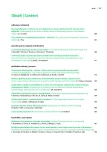Does the time from symptoms onset to treatment impact further development of vein thrombosis in the leg?
Authors:
Jiří Spáčil; Jaroslava Svobodová
Authors‘ workplace:
Cévní ordinace Spamed, Praha
Published in:
Vnitř Lék 2018; 64(10): 911-915
Category:
Original Contributions
Overview
Introduction:
It is unknown how many days pass from the symptom onset to anticoagulation therapy of vein thrombosis (VT) in the leg in our country and whether this time has an impact on further development of the disease.
Methods:
Among patients treated at our department in recent years for deep vein thrombosis in the leg, we selected 50 patients with the required data available. In each case the diagnosis was confirmed by duplex sonography. The mean age was 51 years and the group included 31 males and 19 females. Proximal VT was found in 72 % of the patients. Idiopathic VT was found in 38 % of the patients. The patients were followed for 3–6 months.
Results:
The mean time to initiation of VT therapy was 10 days, range 1–42 days, median 7 days. Two thirds of the patients were treated with novel oral anticoagulants. Residual VT (incomplete recanalization) was present after 1–2 months of the therapy in 40.9 %, and after 3–6 months in 25 % of the patients. The positive relationship between the time to treatment and residual VT was significant both after 1–2 months of therapy (p < 0.05) and after 3–6 months of therapy (p < 0.01).
Conclusion:
The time to VT treatment is clearly longer in our country compared to other countries. Delayed onset of treatment reduces the success rate of the therapy as assessed by an increased risk of residual thrombosis in the affected veins in subsequent months.
Key words:
delayed diagnosis – residual vein thrombosis – vein thrombosis
Sources
- Hull RD, Raskob GE, Brant RF et al. Relation between the time to achieve the Loir limit of the APTT therapeutic range and recurrent venous thromboembolism during heparin treatment for deep vein thrombosis. Arch Intern Med 1997; 157(22): 2562–2568.
- Anand SS, Bates S, Ginsberg JS et al. Recurrent venous thrombosis and heparin therapy: an evaluation of the importance of early activated parcel thromboplastin times. Arch Intern Med 1999; 159(1): 2029–2032.
- Schulman S, Kearon C, Kakkar AK et al. Dabigatran versus Warfarin in the Treatment of Acute Venous Thromboembolism. N Engl J Med 2009; 361(24): 2342–2352. Dostupné z DOI: <http://dx.doi.org/10.1056/NEJMoa0906598>.
- Bauersachs R, Berkowitz SD, Brenner B et al. Oral Rivaroxaban for symptomatic venous thromboembolism. N Engl J Med 2010; 363(26): 2499–2510. Dostupné z DOI: <http://dx.doi.org/10.1056/NEJMoa1007903>.
- Agnelli G, Buller HR, Cohen A et al. Oral Apixaban for the treatment of Acute Venous Thromboembolism. N Engl J Med 2013; 369(9): 799–808. Dostupné z DOI: <http://dx.doi.org/10.1056/NEJMoa1302507>.
- Elliot CG, Goldhaber SZ, Jensen RL. Delays in diagnosis of deep vein thrombosis and pulmonary embolism. Chest 2005; 128(5): 3372–3376. Dostupné z DOI: <http://dx.doi.org/10.1378/chest.128.5.3372>.
- Ageno W, Agnelli G, Imberti D et al. Factors associated with the timing of diagnosis of venous thromboembolis: results from MASTER registry. Thromb Res 2008; 121(6): 751–756. Dostupné z DOI: <http://dx.doi.org/10.1016/j.thromres.2007.08.009>.
- Rahimi-Rad MH, Rahimi-Rad S, Zarrin S. Delays in diagnosis and treatment of venous thromboembolism in a developing country petting. Tuberk Toraks 2013; 61(2): 96–102.
- Tick W, Kramer MHH, Rosendaal FR et al. Risk factors for post-thrombotic syndrome in patients with a first deep venous thrombosis. J Throm Haemost 2008; 6(12): 2075–2081. Dostupné z DOI: <http://dx.doi.org/10.1111/j.1538–7836.2008.03180.x>.
- Rajagopalan S, Dean SM, Mohler ER et al. Manual of Vascular Diseases. 2nd ed. Wolters Kluwer: Philadelphia 2012: 415–438. ISBN 978–1609134228.
- Musil D. [Regression of deep venous thrombosis]. Vnitř Lék 2000; 46(1): 16–18.
- Vítovec M, Golán L, Roztočil K et al. The development of persistent thrombotic masses in patients with deep venous thrombosis randomized to long-term anticoagulation treatment. VASA 2009; 38(3): 238–244. Dostupné z DOI: <https://doi.org/10.1024/0301–1526.38.3.238>.
- Hirmerová J, Seidlerova JM, Filipovský J. Risk factors for residual thrombotic occlusion after proximal deep vein thrombosis of the legs. Int Angiol 2010; 29(4): 317–322.
- Carrier M, Rodger MA, Wells PS et al. Residual vein obstruction to predict the risk of recurrent venous thromboembolism in patients with deep vein thrombosis: a systematic review and meta-analysis. J Thromb Haemost 2011; 9(6): 1119–1132. Dostupné z DOI: <http://dx.doi.org/10.1111/j.1538–7836.2011.04254.x>.
- Stephenson EJ, Liem TK. Duplex imaging of residual venous obstruction to guide duration of therapy for lower extremity deep venous thrombosis. J Vasc Surg Venous Lymphat Disord 2015; 3(3): 326–332. Dostupné z DOI: <http://dx.doi.org/10.1016/j.jvsv.2014.08.003>.
- Prandoni P, Ageno W, Mumoli N et al. Recanalization rate in patients with proximal vein thrombosis treated with the direct oral anticoagulants. Thromb Res 2017; 153: 97–100. Dostupné z DOI: <http://dx.doi.org/10.1016/j.thromres.2017.03.022>.
- Karetová D, Chochola M et al. Vaskulární medicina. Maxdorf-Jesenius: Praha 2017: 285–296. ISBN 978–80–7345–536–1
- Prandoni P, Lensing AW, Prins MH et al. The impact of residual thrombosis on the long-term outcome of patients with deep venous thrombosis treated with conventional anticoagulation. Semin Thromb Hemost 2015; 41(2): 133–140. Dostupné z DOI: <http://dx.doi.org/10.1055/s-0035–1544161>.
- Le Gal G, Carrier M, Kovacs MJ et al. Residual vein obstruction as a predictor for recurrent thromboembolic events after a firs unprovoked episode: data from the REVERSE cohort study. J Thromb Haemost 2011; 9(6): 1126–1132. Dostupné z DOI: <http://dx.doi.org/10.1111/j.1538–7836.2011.04240.x>.
Labels
Diabetology Endocrinology Internal medicineArticle was published in
Internal Medicine

2018 Issue 10
Most read in this issue
- Treatment of polycythemia vera
- Fatty pancreas disease: clinical impact
- Weber-Christian disease: a case report
- Angiotensin-converting enzyme inhibitor-induced angioedema: epidemiology, pathogenesis and management
